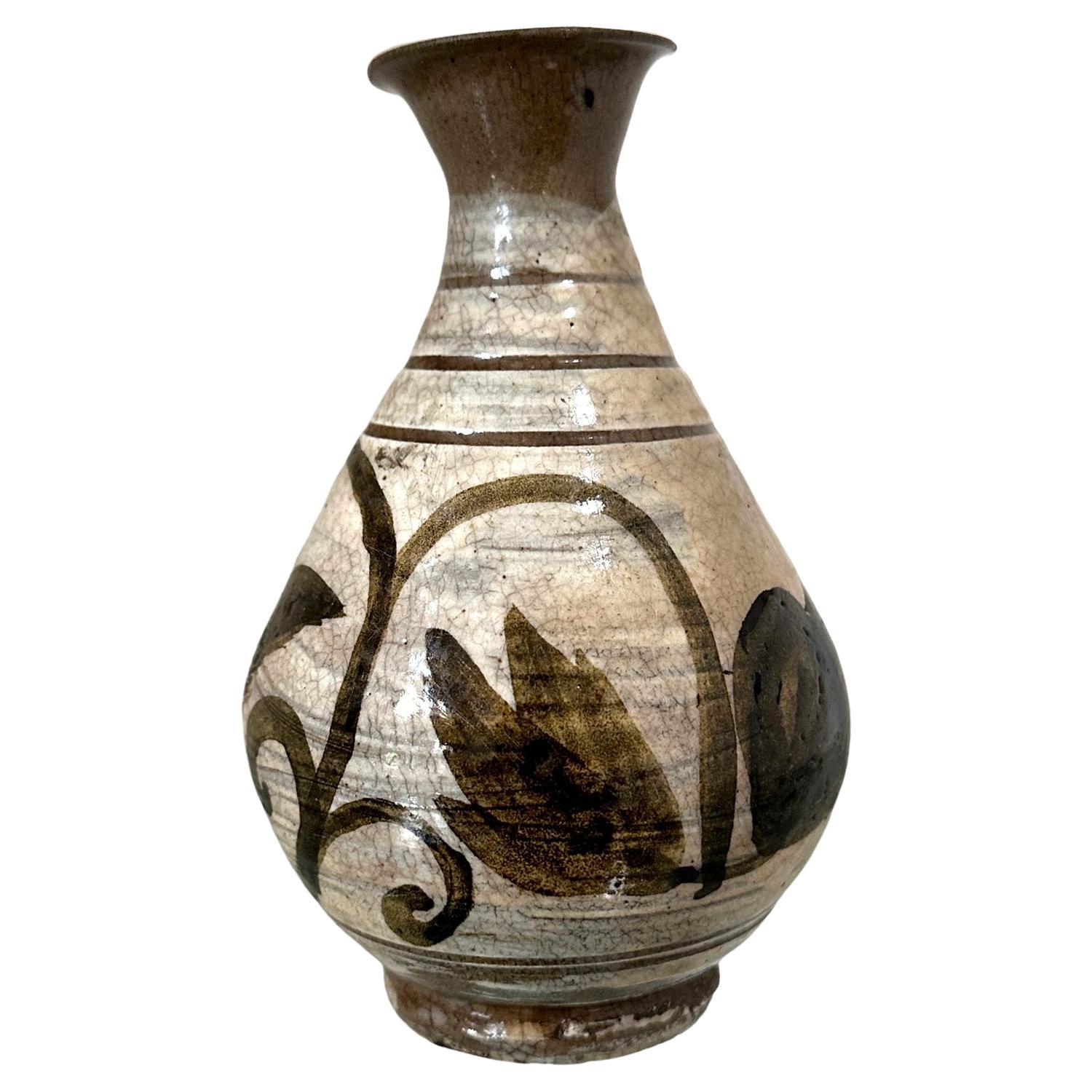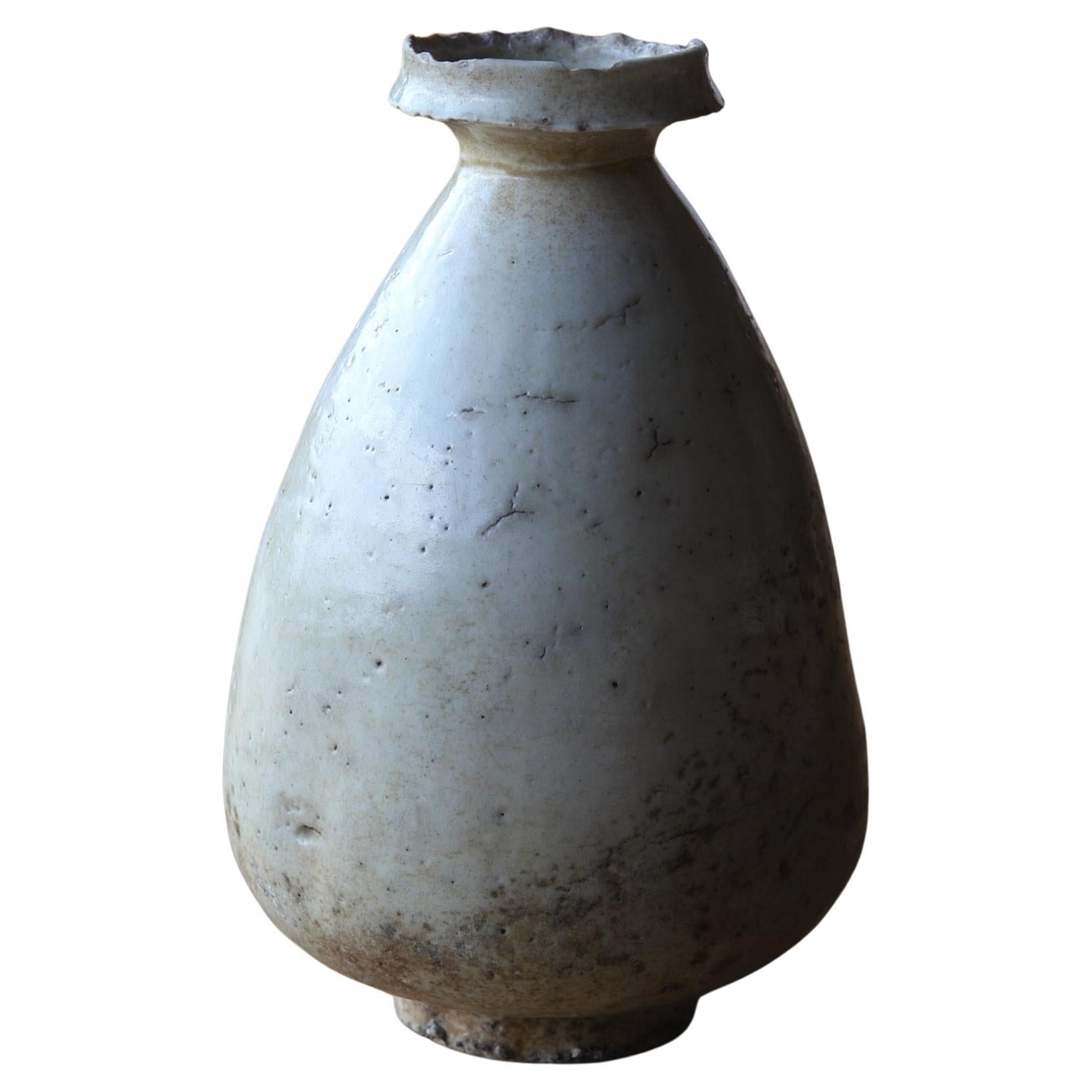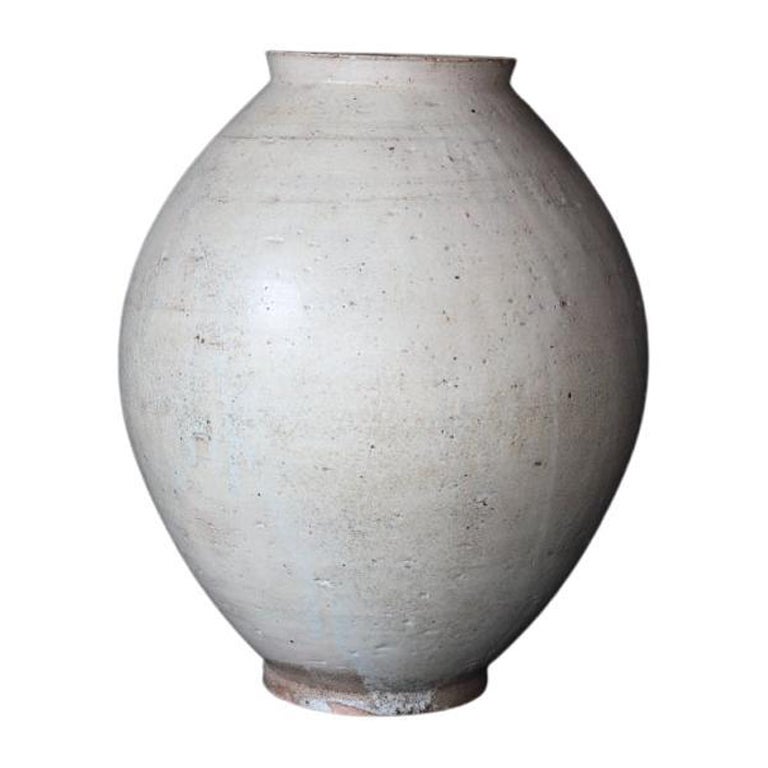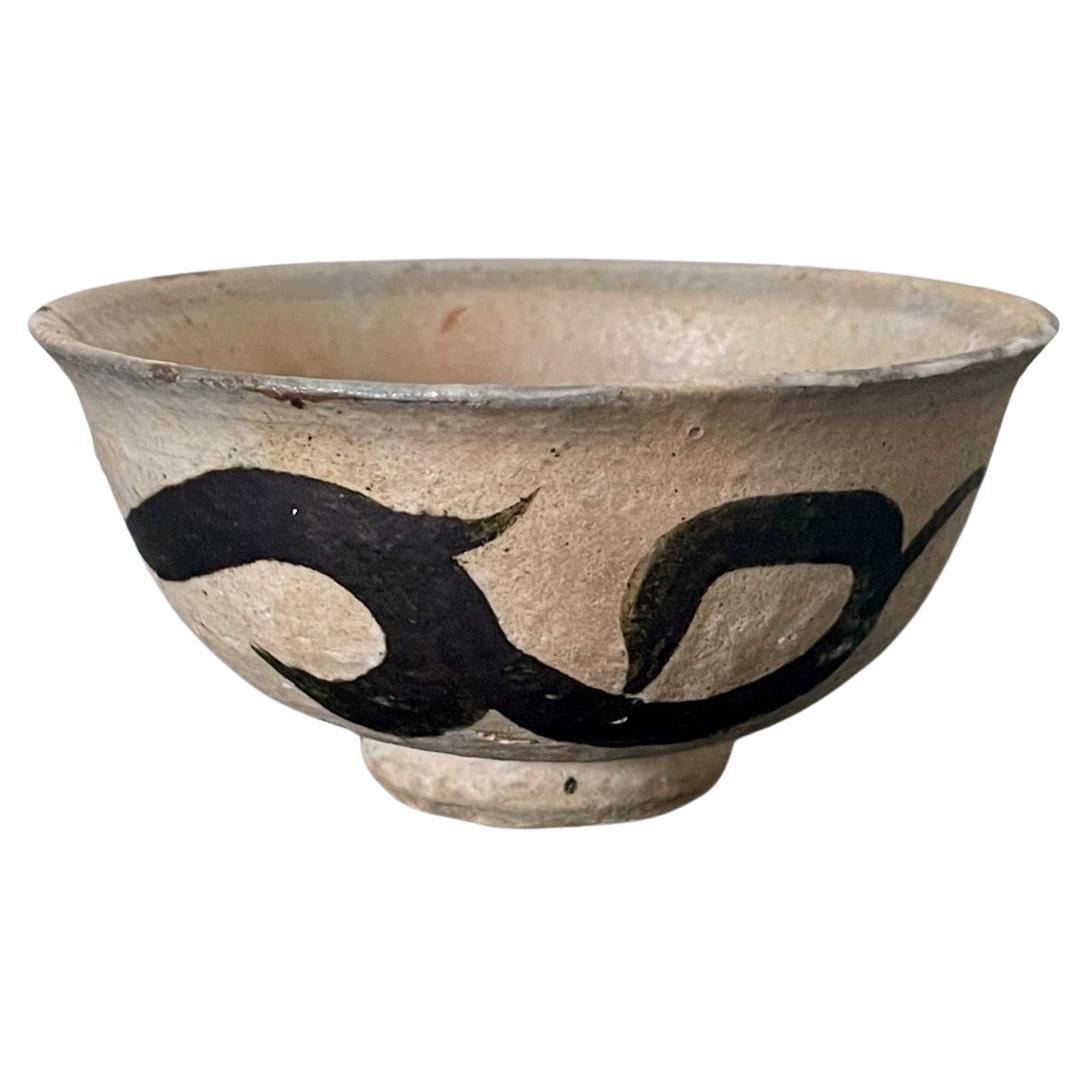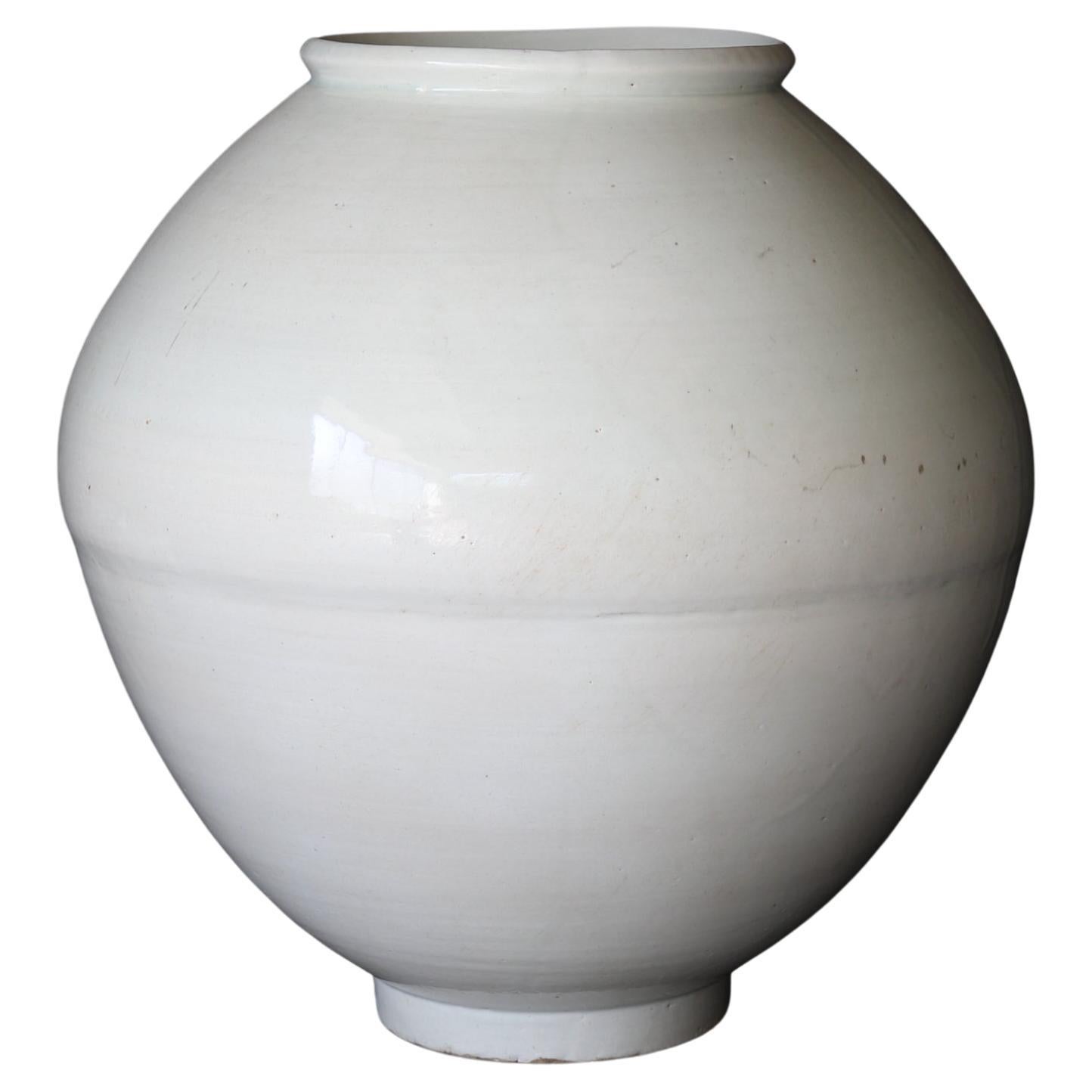Items Similar to Bottle Buncheong Ware / 15th Century / Korean Antiques / Joseon Dynasty
Want more images or videos?
Request additional images or videos from the seller
1 of 19
Bottle Buncheong Ware / 15th Century / Korean Antiques / Joseon Dynasty
About the Item
Powder blue celadon ware is a type of porcelain made in Korea during the first half of the Joseon dynasty, mainly in the 15th century. It was made by applying a fine white slip over iron-rich clay, then covering it with a transparent glaze and firing it. It was mainly used for daily utensils such as bowls and bottles.
Joseon ceramics were known for their unique designs that reflected the culture and environment of the Korean peninsula, and powder blue celadon ware is no exception. The vessel's shape and decoration are typically simple, with delicate and elegant beauty.
The combination of the glazed and unglazed areas produces a unique texture and shading. This particular piece features a boldly applied white slip, with floral patterns expressed through incision and iron decoration. Technically, this is a form of inlaid line work. This technique is extremely rare in powder blue celadon ware, and there are no known examples elsewhere. A wooden box is included.
- Dimensions:Height: 11.42 in (29 cm)Width: 6.7 in (17 cm)Depth: 6.7 in (17 cm)
- Materials and Techniques:
- Place of Origin:
- Period:
- Date of Manufacture:1392-1910 CE
- Condition:
- Seller Location:Kyoto-shi, JP
- Reference Number:1stDibs: LU7673234119902
About the Seller
No Reviews Yet
Vetted Seller
These experienced sellers undergo a comprehensive evaluation by our team of in-house experts.
Established in 2012
1stDibs seller since 2022
- ShippingRetrieving quote...Ships From: Kyoto-shi, Japan
- Return PolicyA return for this item may be initiated within 2 days of delivery.
More From This SellerView All
- White Porcelain Vase / 17th Century / Korean Antiques / Joseon DynastyLocated in Kyoto-shi, KyotoThis product is a white porcelain bottle from the Joseon Dynasty. People in those days used bottles like this to make soap from waste oil. With use, the porcelain frayed and curle...Category
Antique 17th Century Antiquities
MaterialsCeramic, Porcelain
- Moon Jar / Korean Antique vase / Joseon Dynasty / 18th CenturyLocated in Kyoto-shi, KyotoIt's a wonderful moon jar. It is a rare size that is suitable for the alcove of a Japanese tea room. It is shaped at once without connecting the uppe...Category
Antique 18th Century Korean Antiquities
MaterialsCeramic
- Moon Jar 'Dalhanari', Lot3 / 17th Century / Korean Antiques / Joseon DynastyLocated in Kyoto-shi, KyotoThis is a white porcelain jar from the mid-Joseon period, also known as a "Talhunari" or "moon jar". During the Joseon Dynasty, which was strongly influenced by Confucianism, the purity of white porcelain was particularly prized in its artistic expression due to its Confucian sensitivity. The defining characteristic of white porcelain during this period was its pure white color, but there were many subtle variations in the white hues, with some being classified as milky white, snowy white, ashen white, and bluish white. The term "Talhunari" means "moon jar" in Korean, and it refers to the large, round shape of the jar, resembling a full moon. It was named by Kim Whanki, a representative abstract painter of Korea. The soft, curving lines and sturdy body that seems to embrace the full moon give the jar both power and tranquility. This type of jar was produced in large quantities during the 17th century. The white of the moon jar is not the pure white of early Joseon porcelain...Category
Antique 17th Century Korean Ceramics
MaterialsCeramic, Porcelain
- Moon Jar 'Dalhanari' - Lot2 / 17th Century / Korean Antiques / Joseon DynastyLocated in Kyoto-shi, KyotoThis is a white porcelain jar from the mid-Joseon period, also known as a "Talhunari" or "moon jar". During the Joseon Dynasty, which was strongly influenced by Confucianism, the purity of white porcelain was particularly prized in its artistic expression due to its Confucian sensitivity. The defining characteristic of white porcelain during this period was its pure white color, but there were many subtle variations in the white hues, with some being classified as milky white, snowy white, ashen white, and bluish white. The term "Talhunari" means "moon jar" in Korean, and it refers to the large, round shape of the jar, resembling a full moon. It was named by Kim Whanki, a representative abstract painter of Korea. The soft, curving lines and sturdy body that seems to embrace the full moon give the jar both power and tranquility. This type of jar was produced in large quantities during the 17th century. The white of the moon jar is not the pure white of early Joseon porcelain...Category
Antique 17th Century Korean Antiquities
MaterialsCeramic, Porcelain
- White Porcelain Incense Burner / Korean Antique / Joseon Dynasty/1392 - 1897 CELocated in Kyoto-shi, KyotoThis incense burner presents the characteristics of a typical Yi Dynasty Joseon Dynasty incense burner with a body that rises smoothly from the base, openworked ears and a semi-circu...Category
Antique 17th Century Korean Antiquities
MaterialsCeramic
- Sue Ware /Antique Japanese vase/4th-8th century/Wabi-sabiLocated in Kyoto-shi, KyotoThis cup is an example of the type of stoneware known as Sue ware, produced from the middle of the fifth until the fourteenth century in Japan. This produc...Category
Antique 15th Century and Earlier Japanese Antiquities
MaterialsPottery
You May Also Like
- Korean Glazed Ceramic Vase Buncheong Ware Joseon DynastyLocated in Atlanta, GAA small antique Korean Buncheong stoneware vase from early Joseon Dynasty circa 16th century. The vase is of a classic pear form with a waisted neck, a flared mouth and a ringed base...Category
Antique 16th Century Korean Other Ceramics
MaterialsCeramic
- Korean Glazed Ceramic Vase Buncheong Ware Early Joseon DynastyLocated in Atlanta, GAAn antique Korean Buncheong stoneware vase from early Joseon Dynasty circa late 15th to early 16th century. The vase is of a classic pear form with a ...Category
Antique 15th Century and Earlier Korean Archaistic Ceramics
MaterialsCeramic
- Korean Ceramic Buncheong Ware Tea Bowl Early Joseon DynastyLocated in Atlanta, GAAn antique Korean Buncheong stoneware tea bowl (chawan) from early Joseon Dynasty circa late 15th to early 16th century. The bowl with a short ring base is nearly entirely covered in a white slip except the base (known as sougusuri in Japanese, total glaze). Iron-colored scrolling vines were painted on with quick and deft brush strokes, rendering the bowl a vital and spontaneous appeal. It appears that the bowl was dipped in the white slip instead of being brushed on, observing from the slip pattern left on the rim of the bowl. The bowl shows significant age and evident of use for tea drinking. There are losses of glaze flakes throughout, along the rim and inside the bowl. The flake off the glaze left a dark spot on the rim, exposing the deep colored clay underneath. Inside the bowl, many of the glaze flakes appear more superficial and retains a yellowing color from the tea stains (known as amamori, rain leak). There is a historical crack line on the exterior (surface only) that result in associated small losses of glaze. It appears that the crack line was the result from the kiln firing and gradually the glaze around it started to reduce. The bowl comes with a later wrapping cloth and a wood tomobako box, but they are not original to the piece. This particular type of Buncheong ware was associated with the Hakbong-ri kilns in the sacred Mount Gyeryong Mountains, west of Daejeon city in the Chungcheong province. During early Joseon Dynasty, the emperor decided to reject Buddhism to embrace the Confucianism. As a result, many monks were forced to abandon their religious life and returned to the secular society. The monks in Gyeryong mountains set up the kilns and started to produce this so called "Hakbong-ri" type of Buncheong ware. The production was shorted-lived for only a few decades from late 15th to early 16th century before it turned to porcelain, but the ware made during that period was noted for their fresh and enigmatic appeal with deft iron-paint decoration. Collectors cherish these rare pieces for their vitality and spontaneity often used them on important occasions of chado in Japan and passed down to generation. For a similar bowl, see Catalog 52 illustrated on page 87 of the book "Korean Buncheong Ceramics...Category
Antique 15th Century and Earlier Korean Archaistic Ceramics
MaterialsCeramic
- Antique Korean Ceramic Buncheong Bowl Joseon DynastyLocated in Atlanta, GAA Korean ceramic shallow bowl on ring foot in the classic Buncheong (or Punch'ong) style from early Joseon Dynasty circa 15th century. The bowl features...Category
Antique 15th Century and Earlier Korean Archaistic Ceramics
MaterialsCeramic
- Antique Korean Ceramic Buncheong Bowl Joseon DynastyLocated in Atlanta, GAA Korean ceramic bowl supported on a short ring foot in the classic Buncheong (or Punch'ong) style from early Joseon Dynasty circa 15th century. The bow...Category
Antique 15th Century and Earlier Korean Archaistic Ceramics
MaterialsCeramic
- Ceramic Bowl Buncheong Ware Joseon DynastyLocated in Atlanta, GAA Buncheong (also spelled as Punch'ong) stoneware tea bowl from Korea Joseon Dynasty circa 15-16th century. The conical shape bowl in the classical styl...Category
Antique 16th Century Korean Archaistic Ceramics
MaterialsCeramic
Recently Viewed
View AllMore Ways To Browse
Antique It
Antique Powder
Technical Antiques
Antique Slip
Antique Bottle Design
Antique Korean
Antique Korea
Antique Korean Korea
Antique Korean Furniture
Antique Rare Bottles
Antique Blue Bottles
Antique Blue Bottle
Sliping Beauty
Antique Utensils
Antique Fire Boxes
Antique Bottle Shapes
Antique Ceramic Boxes
Antique Fire Box
